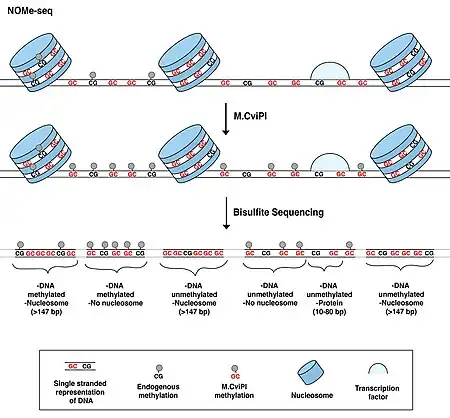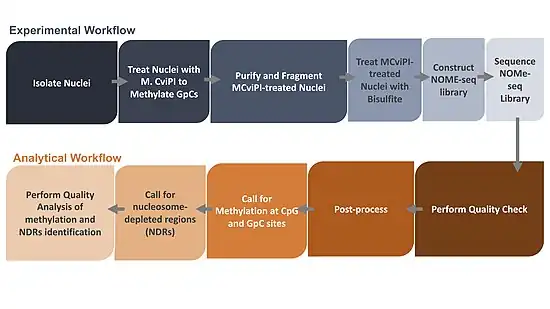NOMe-seq
Nucleosome Occupancy and Methylome Sequencing (NOMe-seq) is a genomics technique used to simultaneously detect nucleosome positioning and DNA methylation...[1] This method is an extension of bisulfite sequencing, which is the gold standard for determining DNA methylation.[2] NOMe-seq relies on the methyltransferase M.CviPl, which methylates cytosines in GpC dinucleotides unbound by nucleosomes or other proteins, creating a nucleosome footprint. The mammalian genome naturally contains DNA methylation, but only at CpG sites, so GpC methylation can be differentiated from genomic methylation after bisulfite sequencing. This allows simultaneous analysis of the nucleosome footprint and endogenous methylation on the same DNA molecules.[1] In addition to nucleosome foot-printing, NOMe-seq can determine locations bound by transcription factors. Nucleosomes are bound by 147 base pairs of DNA[3] whereas transcription factors or other proteins will only bind a region of approximately 10-80 base pairs. Following treatment with M.CviPl, nucleosome and transcription factor sites can be differentiated based on the size of the unmethylated GpC region.[4]

Nucleosome occupancy determines DNA accessibility, which provides insight into regulatory regions of the genome. Important regulatory elements within a cell (such as promoters, enhancers, silencers, etc.), are located in open or accessible regions to allow binding of transcription factors or other regulatory molecules.[3] NOMe-seq can therefore be used to elucidate regulatory information. Alternative DNA accessibility techniques include MNase-seq,[5] DNase-seq,[6] FAIRE-seq,[7] and their successor ATAC-seq.[8] NOMe-seq has the additional benefit of providing DNA methylation status, which also plays a crucial role in the regulation of genomic activity. Interestingly, increased DNA methylation is associated with transcriptional silencing whereas accessible DNA unbound by nucleosomes is generally associated with transcriptional activation. In this sense, NOMe-seq consists of two independent methylation analyses that are functionally oppositional.[9]
History
The M.CviPl methyltransferase was first described in 1998, where the gene was cloned from Chorella virus NYs-1.[10] After its discovery, the methyltransferase was used for nucleosome foot-printing as early as 2004,[11] but NOMe-seq was not officially described until 2012.[12] M.CviPl was not the only methyltransferase used for nucleosome foot-printing; Methylase-sensitive Single Promoter Analysis (M-SPA) was described in 2005 using the CpG methyltransferase M.Sssi.[13][14] M.CviPl techniques quickly overtook M-SPA as GpC specificity is preferable to CpG specificity, with GpC dinucleotides having a broader distribution throughout the genome and no endogenous methylation.[14] The NOMe-seq assay was subsequently developed, with the earliest mention being in 2011[15] and an in depth description published in 2012.[12] The technique has since been adapted for single cell technologies, with single cell NOMe-seq (scNOMe-seq) described in 2017[16] and NOMe-seq using nanopore sequencing (nanoNOMe) described in 2020.[17] These adaptations have allowed high resolution analyses that can compare and contrast DNA accessibility between single cells.[16]
Methods
- Components
- [9]
- For isolating nuclei, components include Dulbecco's phosphate-buffered saline (DPBS), trypsin or dispase (depending on cell type), trypan blue, hemocytometer, lysis buffer, and wash buffer
- To treat nuclei with M.CviPl, components include GpC Buffer, S-adenosylhomocysteine (SAM), M.CviPl, Sucrose, Nuclease-free water, and Stop buffer
- For isolating M.CviPl-treated DNA, components include NaCl, Proteinase K, Phenol:Chloroform (1:1), Ethanol, TE Buffer, and Nandrop spectrophotometer EDTA pH 8
- For fragmenting M.CviPI-treated DNA, components include Covaris sonicator, Covaris MicroTUBE AFA Pre-slit Snap-Cap 6x16mm, Nanodrop Spectrophotometer, and DNA High Sensitivity Kit (Agilent) for use with Agilent 2100 Bioanalyzer
- For bisulfite conversion of M.CviPI-treated DNA, components include EZ DNA Methylation Kit
- For constructing NOMe-seq Library, components include Accel-NGS Methyl-Seq DNA Library Kit for Illumina Platforms, Methyl-Seq Set A Indexing Kit, Magnetic Beads, dsDNA HS Assay Kit, and DNA High Sensitivity Kit

- Isolate Nuclei: Lysation of pelleted cells
- Treat Nuclei with M. CviPl to Methylate GpCs: Incubation with GpC buffer and M.CviPI
- Purify and Fragment MCviPl-treated Nuclei
- Treat MCviPI-treated Nuclei with Bisulfite: Conversion of unmethylated Cs to Ts
- Construct NOME-seq library
- Sequence NOMe-seq Library
- Perform Quality Check: Analysis of the sequence by aligning the sequenced genomic clones to bisulfite converted sequence
- Post-process: Analysis of duplicates and coverage quality
- Call for Methylation at CpG and GpC sites: CpG is found in all HCG trinucleotides; GpC is found in all GCH trinucleotides
- Call for NDRs
- Perform Quality Analysis of methylation and NDRs identification: Visualization of methylation levels
Use
Advantages
- High resolution
- Identifies regulatory elements without needing to understand nucleosome modifications (in comparison to CHIP-seq)
- Greater depth regarding the position of nucleosomes (comparison to DNase-seq, FAIRE-seq, and ATAC-seq.[9]
- Identifies information on dual nucleosome position
- Identifies DNA methylation at a single-DNA molecule resolution
- Relatively short reaction time: 15 minutes while utilizing approximately 200,000 cells.[1]
Limitations
- Relies on the presence of GpC residues: while the broad distribution of GpCs provides high depth information, mapping is still based on GpC presence in regions unbound by nucleosomes or transcription factors and therefore can not provide single nucleotide resolution[18]
- Higher expense compared to other sequencing methods due to the depth in information generated[19]
Other Applications & Complementary Methods
scNOMe-seq
scNOMe-seq is a method that was adapted from NOMe-seq to be used in single cells studies. This has been found to produce similar results as NOMe-seq when using bulk samples of human cell cultures. Single cell analyses have many benefits in cases where gene expression can vary between cells. For example, to further develop cancer treatments, it would be useful to understand the differences that arise between individual cells using the scNOMe-seq method.[16]
nanoNOMe
nanoNOMe is a method that was adapted from NOMe-seq that uses nanopore sequencing instead of bisulfite sequencing. Nanopore sequencing is a long read sequencing method that also detects DNA methylation, providing additional insight into longe range patterns on individual molecules.[17]
NOMePlot
NOMePlot is a bioinformatic tool that was developed for datasets derived by NOMe-seq. This tool easily obtains single molecule locus-specific information in genome-wide datasets from bulk cell populations and has been validated using mouse embryonic stem cells.[20]
See also
References
- Lay, Fides D.; Kelly, Theresa K.; Jones, Peter A. (2018), Tost, Jörg (ed.), "Nucleosome Occupancy and Methylome Sequencing (NOMe-seq)", DNA Methylation Protocols, New York, NY: Springer, vol. 1708, pp. 267–284, doi:10.1007/978-1-4939-7481-8_14, ISBN 978-1-4939-7481-8, PMID 29224149, retrieved 2023-02-28
- Li, Yuanyuan; Tollefsbol, Trygve O. (2011). "DNA methylation detection: Bisulfite genomic sequencing analysis". Epigenetics Protocols. Methods in Molecular Biology. Vol. 791. pp. 11–21. doi:10.1007/978-1-61779-316-5_2. ISBN 978-1-61779-315-8. ISSN 1064-3745. PMC 3233226. PMID 21913068.
- Tsompana, Maria; Buck, Michael J. (2014-11-20). "Chromatin accessibility: a window into the genome". Epigenetics & Chromatin. 7 (1): 33. doi:10.1186/1756-8935-7-33. ISSN 1756-8935. PMC 4253006. PMID 25473421.
- "NOMe-Seq (Nucleosome Occupancy and Methylome Sequencing)". www.activemotif.com. Retrieved 2023-02-28.
- Johnson, Steven M.; Tan, Frederick J.; McCullough, Heather L.; Riordan, Daniel P.; Fire, Andrew Z. (December 2006). "Flexibility and constraint in the nucleosome core landscape of Caenorhabditis elegans chromatin". Genome Research. 16 (12): 1505–1516. doi:10.1101/gr.5560806. ISSN 1088-9051. PMC 1665634. PMID 17038564.
- Boyle, Alan P.; Davis, Sean; Shulha, Hennady P.; Meltzer, Paul; Margulies, Elliott H.; Weng, Zhiping; Furey, Terrence S.; Crawford, Gregory E. (2008-01-25). "High-resolution mapping and characterization of open chromatin across the genome". Cell. 132 (2): 311–322. doi:10.1016/j.cell.2007.12.014. ISSN 1097-4172. PMC 2669738. PMID 18243105.
- Giresi, Paul G.; Kim, Jonghwan; McDaniell, Ryan M.; Iyer, Vishwanath R.; Lieb, Jason D. (2006-12-19). "FAIRE (Formaldehyde-Assisted Isolation of Regulatory Elements) isolates active regulatory elements from human chromatin". Genome Research. 17 (6): 877–885. doi:10.1101/gr.5533506. ISSN 1088-9051. PMC 1891346. PMID 17179217.
- Buenrostro, Jason D.; Wu, Beijing; Chang, Howard Y.; Greenleaf, William J. (January 2015). "ATAC‐seq: A Method for Assaying Chromatin Accessibility Genome‐Wide". Current Protocols in Molecular Biology. 109 (1): 21.29.1–21.29.9. doi:10.1002/0471142727.mb2129s109. ISSN 1934-3639. PMC 4374986. PMID 25559105.
- Rhie, Suhn Kyong; Schreiner, Shannon; Farnham, Peggy J. (2018). "Defining Regulatory Elements in the Human Genome Using Nucleosome Occupancy and Methylome Sequencing (NOMe-Seq)". CPG Islands. Methods in Molecular Biology. Vol. 1766. pp. 209–229. doi:10.1007/978-1-4939-7768-0_12. ISBN 978-1-4939-7767-3. ISSN 1940-6029. PMC 6019634. PMID 29605855.
- Xu, M.; Kladde, M. P.; Van Etten, J. L.; Simpson, R. T. (1998-09-01). "Cloning, characterization and expression of the gene coding for a cytosine-5-DNA methyltransferase recognizing GpC". Nucleic Acids Research. 26 (17): 3961–3966. doi:10.1093/nar/26.17.3961. ISSN 0305-1048. PMC 147793. PMID 9705505.
- Jessen, Walter J; Dhasarathy, Archana; Hoose, Scott A; Carvin, Christopher D; Risinger, April L; Kladde, Michael P (2004-05-01). "Mapping chromatin structure in vivo using DNA methyltransferases". Methods. In vitro analysis of chromatin structure in model systems. 33 (1): 68–80. doi:10.1016/j.ymeth.2003.10.025. ISSN 1046-2023. PMID 15039089.
- Kelly, Theresa K.; Liu, Yaping; Lay, Fides D.; Liang, Gangning; Berman, Benjamin P.; Jones, Peter A. (December 2012). "Genome-wide mapping of nucleosome positioning and DNA methylation within individual DNA molecules". Genome Research. 22 (12): 2497–2506. doi:10.1101/gr.143008.112. ISSN 1088-9051. PMC 3514679. PMID 22960375.
- Fatemi, Mehrnaz; Pao, Martha M.; Jeong, Shinwu; Gal-Yam, Einav Nili; Egger, Gerda; Weisenberger, Daniel J.; Jones, Peter A. (2005-11-27). "Footprinting of mammalian promoters: use of a CpG DNA methyltransferase revealing nucleosome positions at a single molecule level". Nucleic Acids Research. 33 (20): e176. doi:10.1093/nar/gni180. ISSN 1362-4962. PMC 1292996. PMID 16314307.
- Wolff, Erika M.; Byun, Hyang-Min; Han, Han F.; Sharma, Shikhar; Nichols, Peter W.; Siegmund, Kimberly D.; Yang, Allen S.; Jones, Peter A.; Liang, Gangning (2010-04-22). "Hypomethylation of a LINE-1 promoter activates an alternate transcript of the MET oncogene in bladders with cancer". PLOS Genetics. 6 (4): e1000917. doi:10.1371/journal.pgen.1000917. ISSN 1553-7404. PMC 2858672. PMID 20421991.
- Han, Han; Cortez, Connie C.; Yang, Xiaojing; Nichols, Peter W.; Jones, Peter A.; Liang, Gangning (2011-11-15). "DNA methylation directly silences genes with non-CpG island promoters and establishes a nucleosome occupied promoter". Human Molecular Genetics. 20 (22): 4299–4310. doi:10.1093/hmg/ddr356. ISSN 1460-2083. PMC 3196883. PMID 21835883.
- Pott, Sebastian (2017-06-27). Ren, Bing (ed.). "Simultaneous measurement of chromatin accessibility, DNA methylation, and nucleosome phasing in single cells". eLife. 6: e23203. doi:10.7554/eLife.23203. ISSN 2050-084X. PMC 5487215. PMID 28653622.
- Lee, Isac; Razaghi, Roham; Gilpatrick, Timothy; Molnar, Michael; Gershman, Ariel; Sadowski, Norah; Sedlazeck, Fritz J.; Hansen, Kasper D.; Simpson, Jared T.; Timp, Winston (December 2020). "Simultaneous profiling of chromatin accessibility and methylation on human cell lines with nanopore sequencing". Nature Methods. 17 (12): 1191–1199. doi:10.1038/s41592-020-01000-7. ISSN 1548-7105. PMC 7704922. PMID 33230324.
- Ishii, Haruhiko; Kadonaga, James T.; Ren, Bing (2015-07-07). "MPE-seq, a new method for the genome-wide analysis of chromatin structure". Proceedings of the National Academy of Sciences of the United States of America. 112 (27): E3457–E3465. Bibcode:2015PNAS..112E3457I. doi:10.1073/pnas.1424804112. ISSN 0027-8424. PMC 4500276. PMID 26080409.
- Nordström, Karl J. V.; Schmidt, Florian; Gasparoni, Nina; Salhab, Abdulrahman; Gasparoni, Gilles; Kattler, Kathrin; Müller, Fabian; Ebert, Peter; Costa, Ivan G.; DEEP consortium; Pfeifer, Nico; Lengauer, Thomas; Schulz, Marcel H.; Walter, Jörn (2019-11-18). "Unique and assay specific features of NOMe-, ATAC- and DNase I-seq data". Nucleic Acids Research. 47 (20): 10580–10596. doi:10.1093/nar/gkz799. ISSN 1362-4962. PMC 6847574. PMID 31584093.
- Requena, Francisco; Asenjo, Helena G.; Barturen, Guillermo; Martorell-Marugán, Jordi; Carmona-Sáez, Pedro; Landeira, David (2019-05-31). "NOMePlot: analysis of DNA methylation and nucleosome occupancy at the single molecule". Scientific Reports. 9 (1): 8140. Bibcode:2019NatSR...9.8140R. doi:10.1038/s41598-019-44597-2. ISSN 2045-2322. PMC 6544651. PMID 31148571.